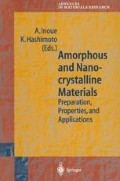Summary
The thermal stability in the supercooled liquid region was examined for Pd82Si18, Pd76Cu6Si18, Pd40Ni10Cu30P20 and Zr6oAl15Ni25 glasses by means of mainly in-situ electrical resistance measurement carried out under various atmospheres, such as Ar, He, H2 and vacuum. A clear variation was found out in the slope of electrical resistance curve after glass transition for all glasses. The glass transition and crystallization temperatures corresponded to those obtained by differential scanning calorimetry. No crystallites were detected in a Zr60Al15Ni25, Pd76Cu6Si18 and Pd40Ni10Cu30P20 glasses heated to the supercooled liquid region at least within X-ray diffraction and transmission electron microscopy. Some anomalous behaviors of electrical resistance were observed around room temperature for Pd-Si based glasses and in the super-cooled liquid region for a Pd40Ni10Cu30P20 glass, possibly resulting from hydrogen absorption and desorption. On the other hand, the behavior of electrical resistance for a Zr60Al15Ni25 glass was strongly dependent on the surface state of the sample, containing the oxidation. The change in electrical resistance after glass transition was also examined in detail and explained by Faber-Zimann theory for Pd76Cu6Si18 and Pd40Ni10Cu30P20 glasses.
Access this chapter
Tax calculation will be finalised at checkout
Purchases are for personal use only
Preview
Unable to display preview. Download preview PDF.
References
A. Inoue, T. Zhang and T. Masumoto: Zr-Al-Ni amorphous alloys with high glass transition temperature and significant supercooled liquid region. Mater. Trans. JIM 31, 177–183 (1990)
A. Peker and W.L. Johnson: A highly processable metallic glass: Zr41.2Ti13.8Cu12.5Ni10.0Be22.5. Appl. Phys. Lett. 63, 2342–2344 (1990)
A. Inoue, M. Kohinata, A.P. Tsai and T. Masumoto: Mg-Ni-La amorphous alloys with a wide supercooled liquid region. Mater. Trans. JIM 30, 378–381 (1989)
A. Inoue, T. Zhang and T. Masumoto: Al-La-Ni amorphous alloys with a wide super cooled liquid region. Mater. Trans. JIM 30, 965–972 (1989)
A. Inoue, N. Nishiyama and T. Matsuda: Preparation of bulk Pd40Ni10Cu30P20 alloy of 40 mm in diameter by water quenching. Mater. Trans. JIM 37, 181–184 (1996)
H.S. Chen and D. Turnbull: Formation, Stability and structure of palladiumsilicon based alloy glasses. Acta Metal. 17, 1021–1031 (1971)
O. Haruyama, H.M. Kimura and A. Inoue: Thermal stability of Zr-based glassy alloys examined by electrical resistance measurement. Mater. Trans. JIM 37, 1741–1747 (1996)
O. Haruyama, H. Kimura, T. Aoki, N. Nishiyama and A. Inoue: Thermal stability of Pd-based metallic glasses examined by electrical resistance measurement. Sci. Rep. RITU A 43, 97–100 (1997)
R. Brüning: Structural relaxation and the glass transition in metallic glasses. A doctoral thesis, McGill University, 1990
Y. Lanping and H. Yizhen: Correlation between the microstructure and internal friction peaks of metallic glass Pd77.5Ni6.0Si16.5. J. Non-Cryst. Solids 105, 33–38 (1988)
N. Nishiyama and A. Inoue: Glass transition behavior and viscous flow working of Pd40Ni10Cu30P20 amorphous alloy. Mater. Trans. JIM, received
T. Masumoto and R. Maddin: The mechanical properties of palladium 20 a/o silicon alloy quenched from the liquid state. Acta Metal. 19, 725–741 (1971)
G. Yiqin, Z. Fuqian, L.Xiong and L. Zongyao: Viscosity of metallic glasses PdCu6Si16.5, PdNi6S16.5 and CuZr43 and their activation energies of viscous flow. Acta Met. Sin. 18, 696–701 (1982)
H. Kimura, A. Inoue, N. Nishiyama, K. Sasamori, O. Haruyama and T. Masumoto: Thermal, mechanical and physical properties of supercooled liquid in Pd-Cu-Ni-P. Sci. Rep. RITU A 43, 101–106 (1997)
H. Uchida, Y. Ohtani, M. Ozawa, T. Kawahata and T. Suzuki: Surface processes of H2 in the initial activation of LaNi5- J. Less-Common Met. 172/174, 983–996 (1991)
A.K. Doolittle: Studies in Newtonian flow. II. The dependence of the viscosity of liquids on free-space. J. Appl. Phys. 22, 1471–1475 (1951)
Y. Yamada, Y. Itoh, T. Matsuda and U. Mizutani: Electron transport studies of Ni33Zr67-based metallic glasses containing H, B, Al and Si. J. Phys. F:Met. Phys. 17, 2313–2322 (1987)
J. Garaguly, A. Lovas, Cziriki, M. Reybold, J. Takics, K. Wetzig: Reversible and irreversible hydrogen absorption in Ni67-xCuxZr33 glasses monitored by in situ resistivity measurements. Mater. Sci. and Eng. A 226–228, 938–942 (1997)
G. Petǭ, I. Bakonyi, K. Tompa and L. Guczi: Photoemission investigation of the elctronic-structure changes in Zr-Ni-Cu metallic glasses upon hydrogenation. Phys. Rev. B 52, 7151–7158 (1995)
H. Kimura, M. Kishida, T. Kaneko, A. Inoue and T. Masumoto: Physical and Mechanical Properties of Zr-Based Metallic Glasses. Mater. Trans. JIM 36, 890–895 (1995)
M. Horino, N. Nishiyama, Y. Yokoyama and A. Inoue: unpublished research
J. H. Mooij: Electrical Conduction in Concentrated Disordered Transition Metal Alloys. Phys. Stat. Sol.(a) 17, 521–530 (1973)
J. S. Dugdale: The electrical properties of disordered metals, (Cambridge University press 1995)
U. Mizutani and T. B. Massalski: Hall-effect measurements and the electronic structure of amorphous Pd-Si-(Cu) alloys. Rhys. Rev. B 21, 3180–3183(1980)
S.S. Jaswal: Electronic structure and properties of transition-metal-metalloid glasses: Ni1-xPx. Phys. Rev. B 34, 8937–8940 (1986)
A. P. Cracknell: The Fermi Surface. II. d-block and f-block Metals. Adv. Phys. 20, 1–141 (1971)
Author information
Authors and Affiliations
Editor information
Editors and Affiliations
Rights and permissions
Copyright information
© 2001 Springer-Verlag Berlin Heidelberg
About this chapter
Cite this chapter
Haruyama, O., Kimura, H., Nishiyama, N., Aoki, T., Inoue, A. (2001). The Anomalous Behavior of Electrical Resistance for Some Metallic Glasses Examined in Several Gas Atmospheres or in a Vacuum. In: Inoue, A., Hashimoto, K. (eds) Amorphous and Nanocrystalline Materials. Advances in Materials Research, vol 3. Springer, Berlin, Heidelberg. https://doi.org/10.1007/978-3-662-04426-1_3
Download citation
DOI: https://doi.org/10.1007/978-3-662-04426-1_3
Publisher Name: Springer, Berlin, Heidelberg
Print ISBN: 978-3-642-08664-9
Online ISBN: 978-3-662-04426-1
eBook Packages: Springer Book Archive

